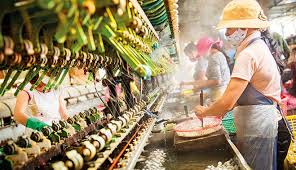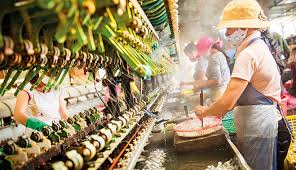
Masking concern about the protectionist leanings of U.S. President-elect Donald Trump and an OPEC-induced oil price rally, China's factories notched their strongest growth in activity in two years and Japanese firms' order books rose in November.
While activity in Japan's factories was still growing in November, the pace was slower than in October, factory surveys produced stronger purchasing manager index (PMI) numbers in China, Taiwan and Vietnam.
But since the effects of stimulus measures in some parts of Asia are wearing off, some analysts cautioned that November might be as good as it gets.
"The strength in PMI numbers is unlikely to be sustained as much of it can be explained by previous stimulus measures. We see increased signs of slowdown in domestic economies, particularly in China," said Julian Evans-Pritchard, an economist at Capital Economics based in Singapore.
Asia's export-driven economies were also worried about an uncertain outlook for global trade.
"We are still envisaging a little bit of global trade momentum from where we are now, but there is so much uncertainty at the moment in the world," Louis Kuijs, head of Asia economics at Oxford Economics said.
Trump will probably adopt more fiscal expansion, which should boost U.S. economic growth.
"But here in Asia, we are still waiting very much to see what the Trump presidency will mean for things like trade policies and trade restrictions," Kuijs said.
Trump’s protectionist comments while campaigning for the presidency could herald problems ahead for Asia and he has already declared his intention to withdraw from an Asia-Pacific free trade agreement once he is inaugurated on Jan. 20.
Staying above the 50-point mark that separates growth from contraction on a monthly basis, China's official PMI rose to 51.7 in November from October's 51.2.
But, suggesting the stronger headline number was consequence of demand coming from its frothy property sector, which authorities are trying to cool, analysts noted a worrying lack of expansion in new export orders for Chinese factories.
"The strength in PMI numbers is unlikely to be sustained as much of it can be explained by previous stimulus measures. We see increased signs of slowdown in domestic economies, particularly in China," said Julian Evans-Pritchard, an economist at Capital Economics based in Singapore.
Since perhaps it focuses on smaller firms which benefit less from government support for the economy, the unofficial Caixin survey showed a more modest increase in activity.
Up from 50.8 in October, there was a rise to a 10-month high of 51.1 in November in a sub-index for new orders, which measures both domestic and external demand while growth in activity was slower in Japan.
Economists say it will be difficult for manufacturers to pass on to customers the cost of higher input materials and said demand is still fragile, even though an improvement in the U.S. and European economies could augur well for exporters.
Resulting in the biggest month-on-month decline in its PMI since March 2013, India's factory activity was still expanding but growth slowed in November.
Recently Prime Minister Narendra Modi ordered 500 rupee and 1,000 rupee banknotes to be removed from circulation and analysts said the slowdown was probably due to a convulsion in demand from that event.
(Source:www.reuters.com)
While activity in Japan's factories was still growing in November, the pace was slower than in October, factory surveys produced stronger purchasing manager index (PMI) numbers in China, Taiwan and Vietnam.
But since the effects of stimulus measures in some parts of Asia are wearing off, some analysts cautioned that November might be as good as it gets.
"The strength in PMI numbers is unlikely to be sustained as much of it can be explained by previous stimulus measures. We see increased signs of slowdown in domestic economies, particularly in China," said Julian Evans-Pritchard, an economist at Capital Economics based in Singapore.
Asia's export-driven economies were also worried about an uncertain outlook for global trade.
"We are still envisaging a little bit of global trade momentum from where we are now, but there is so much uncertainty at the moment in the world," Louis Kuijs, head of Asia economics at Oxford Economics said.
Trump will probably adopt more fiscal expansion, which should boost U.S. economic growth.
"But here in Asia, we are still waiting very much to see what the Trump presidency will mean for things like trade policies and trade restrictions," Kuijs said.
Trump’s protectionist comments while campaigning for the presidency could herald problems ahead for Asia and he has already declared his intention to withdraw from an Asia-Pacific free trade agreement once he is inaugurated on Jan. 20.
Staying above the 50-point mark that separates growth from contraction on a monthly basis, China's official PMI rose to 51.7 in November from October's 51.2.
But, suggesting the stronger headline number was consequence of demand coming from its frothy property sector, which authorities are trying to cool, analysts noted a worrying lack of expansion in new export orders for Chinese factories.
"The strength in PMI numbers is unlikely to be sustained as much of it can be explained by previous stimulus measures. We see increased signs of slowdown in domestic economies, particularly in China," said Julian Evans-Pritchard, an economist at Capital Economics based in Singapore.
Since perhaps it focuses on smaller firms which benefit less from government support for the economy, the unofficial Caixin survey showed a more modest increase in activity.
Up from 50.8 in October, there was a rise to a 10-month high of 51.1 in November in a sub-index for new orders, which measures both domestic and external demand while growth in activity was slower in Japan.
Economists say it will be difficult for manufacturers to pass on to customers the cost of higher input materials and said demand is still fragile, even though an improvement in the U.S. and European economies could augur well for exporters.
Resulting in the biggest month-on-month decline in its PMI since March 2013, India's factory activity was still expanding but growth slowed in November.
Recently Prime Minister Narendra Modi ordered 500 rupee and 1,000 rupee banknotes to be removed from circulation and analysts said the slowdown was probably due to a convulsion in demand from that event.
(Source:www.reuters.com)





